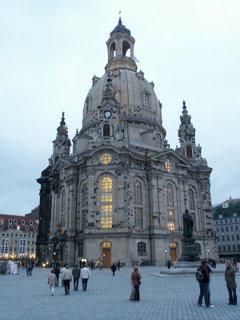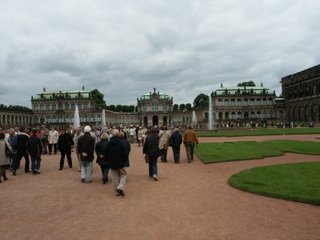 This is a short trip, so we do not have a lot of time for Dresden. We return to Berlin this evening. It is still icy chilly and we need gloves for comfort. Ron insists on making the most of the time, so we walk all over the city and take public transport when necessary.
This is a short trip, so we do not have a lot of time for Dresden. We return to Berlin this evening. It is still icy chilly and we need gloves for comfort. Ron insists on making the most of the time, so we walk all over the city and take public transport when necessary.
In spite of the bombing in WWII, there are still many highlights in this city. The Baroque Frauenkirche or Church of Our Lady is one of them. It is a Protestant sandstone church built in the 18th century, but was leveled during the war. A 12 year reconstruction project was undertaken at the cost of $160 million to bring it back to its original appearance. This was completed in October 2005. Architects and historians were able to piece together the original bricks that were still useable using archives and photos to put them in their original places. The church looks spotted as a result. The dark fire burned bricks stand out from the new replacement bricks surrounding them, giving the church a sense of resurrection or a phoenix rising from the ashes. Of the original stones, 8,425 were salvaged to be part of the reconstruction.

In the same area is a long wall with a 100-meter long porcelain mosaic called Fürstenzug. It is the ‘Procession of the Dukes’ displaying the rulers of Saxony. Nearby is the Semperoper opera house. It was built by Gottfried Semper, thus its name, in the mid-19th century. It is said to be one of Germany's finest examples of neo-renaissance architecture. Fire destroyed it in 1869 and again in 1945. The current building is an exact replica of the original.
The river Elbe runs through the city and divides it in two. We walked over the bridge a few times and enjoyed the views from both sides.
One of the most amazing sights for us was the Zwinger. This amazing complex was commissioned by Augustus II (the Strong), the elector of Saxony and king of Poland due to his passion for collecting paintings, sculpture, antiquities, but especially porcelain. His collection included 14,500 pieces of porcelain from China and Japan. He established the porcelain factory at Meissen in 1710. Augustus admitted his passion for porcelain was his maladie de porcelaine (porcelain sickness).
commissioned by Augustus II (the Strong), the elector of Saxony and king of Poland due to his passion for collecting paintings, sculpture, antiquities, but especially porcelain. His collection included 14,500 pieces of porcelain from China and Japan. He established the porcelain factory at Meissen in 1710. Augustus admitted his passion for porcelain was his maladie de porcelaine (porcelain sickness).
Augustus began to build the Zwinger in 1711. It resembles a palace and can easily be mistaken for one. The architect Matthaus Daniel Poppelmann designed it. The Zwinger was destroyed during World War II and partly reconstructed in 1952 and 1963. Now it is fully reconstructed and restored, displaying the famous porcelain collection.
This evening, we take the train back to Berlin.
Monday, June 05, 2006
Back to Dresden
Posted by
Anonymous
at
9:44 AM
![]()
![]()
Labels: Berlin, Dresdner Frauenkirche, Germany, history, Meissen, Semperoper, Twentieth Century, World War II
Subscribe to:
Post Comments (Atom)
![Reblog this post [with Zemanta]](http://img.zemanta.com/reblog_e.png?x-id=cafc5743-c630-458c-a297-057d31b0100e)















0 comments:
Post a Comment